Plymouth
The town founded in 1620 by the Puritan colonists from the Mayflower still exists, albeit somewhat changed from the representation found at Plimoth Plantation. The name Plymouth is not a result of the Pilgrim Fathers finally leaving England from Plymouth after getting rid of the leaky Speedwell, the name pre-dates the arrival of the Mayflower. The area was given the name New Plimoth in 1614 by Captain John Smith, a leader of the colony at Jamestown, Virginia. The Pilgrim fathers adapted Smith’s name for their settlement, spelling it as either Plimouth or Plymouth, but the modern town is known only as Plymouth. The settlement was founded on the site of a Wampanoag Indian settlement whose residents had died as a result of European diseases such as smallpox. The colonists initially struggled to find food in their new home, but local Indians taught them how to catch fish and grow corn. After a plentiful harvest in 1621 the colonists gather with some of the Indians who had helped them to give thanks to God. This is the origin of the modern day Thanksgiving throughout the USA. Plymouth was first permanent settlement in New England and it served as the capital of Plymouth Colony until 1691 when the colony merged with others to form the Province of Massachusetts Bay. This left Plymouth as a rather isolated fishing town. Nowadays the town of Plymouth is readily accessible from Boston which has boosted growth and made it a significant tourist destination. It is the home of Plymouth Rock which may or (more likely) may not be the rock on which the Pilgrims landed.
Jenney Museum, Summer Street, Plymouth, MA, USA
Located close to the Grist Mill, this historic house dating from 1749 is now a museum and Pilgrim educational centre. The history of the house had been forgotten when in 1969 new owners started renovations that identified that it was a building of considerable age. Some of the timber was found to have came from a 1622 fort that Samuel Jenney reused when constructing the building. In 2008 the building was handed over to Trustees who are renovating it and have opened it as the Jenney Museum focusing on the Pilgrim history of Plymouth and providing walking tours around the town.
Jabez Howland House, Sandwich Street
Originally this was a single storey house built by Jacob Mitchell in about 1667. In 1670 he sold it to Jabez Howland who added a second floor and lived there with his family until he moved to Bristol, Rhode Island in 1680. Jabez was the son of John Howland who arrived aboard the Mayflower, but John’s claim to fame is that for a short time during the voyage he was not aboard the Mayflower. He was swept overboard during high seas but fortunately he grabbed a halyard which kept him close to the ship and he was hauled back aboard using a boat hook. The incident does not appear to have shortened his life; he was in his 80s when he died in 1672, the last surviving male passenger from the Mayflower living in Plymouth. John Howland stayed in this house during his last winters and it was where he died. It is the only building still standing in Plymouth that is known to have been occupied by a passenger from the Mayflower. The Jabez Howland House is owned by the Pilgrim John Howland Society who operate it as an historic house museum.
Plimoth Grist Mill (Jenney Grist Mill), Spring Lane
John Jenney was a Pilgrim who arrived in Plymouth in 1623 aboard the ship ‘Little James’. In 1636 he built a grist mill on Town Brook in Plymouth. Jenney died in 1644 leaving the mill his wife, who continue to operate it until her death when her son Samuel took over. After Samuel the mill continued to operate under several owners until in the 1840s it burned down. It was reconstructed at its original location in 1969-70 as part of an urban renewal project. The fully operational mill was opened to the public as Jenney Grist Mill. Many of the parts such as stones, spindle, and stone furniture came from a mill near Philadelphia, PA. In 2012 the mill was acquired by Plimoth Plantation who, for some reason, decided to drop its historic name and rename it Plimoth Grist Mill. Click Tab 2 to see the Gear Room in the mill.
DLU180116
Click on Minimap to navigate
Mayflower Society House, Winslow Street
The Mayflower Society is an organisation for people who have documented descent from one or more of the 102 people who arrived in 1620 aboard the Mayflower. The society owns the former mansion of Edward Winslow which was built in 1754. The headquarters and library of the society are in a building behind the mansion while the mansion itself is operated as a house museum. Winslow was the great- grandson of Pilgrim Edward Winslow, the third Governor of Plymouth Colony. He was a staunch loyalist so early in the Revolutionary War he moved to Nova Scotia where he died in 1784. The mansion is open for public guided tours between mid May and late October.
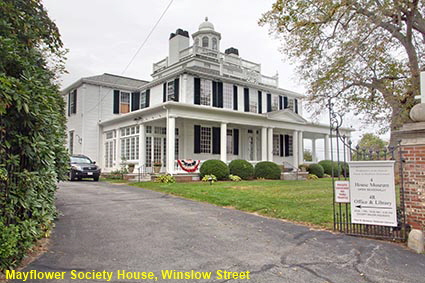
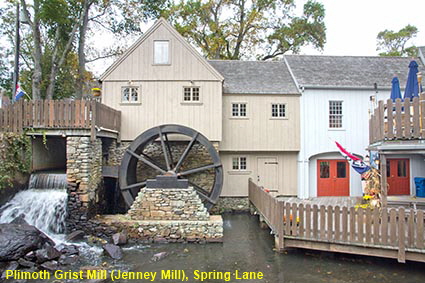
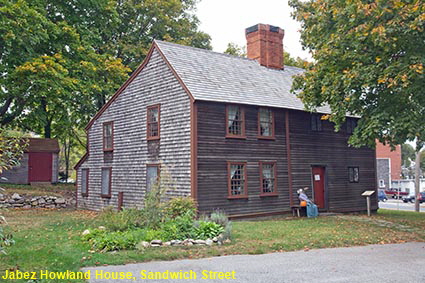
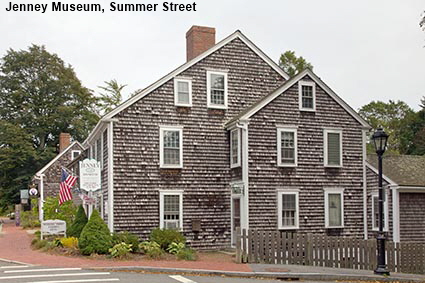


To move forwards or backwards through the Massachusetts trail click the arrows above, or select your next destination on the Minimap.
Home > US States > New England > Massachusetts > Cape Cod >
Mayflower 2
The Pilgrim Fathers were not rich and transport to the New World proved to be a problem. They scraped together enough money to buy a small ship called the Speedwell and hired another called the Mayflower. When the Speedwell turned out to be unseaworthy they all had to cram in to the Mayflower. The Mayflower 2 is a full sized replica moored at Plymouth and it shows just how small the ship was. At only 32 metres (106 feet) long and 8 metres (25 feet) wide life must have been very difficult for the 102 people on board. The voyage lasted 66 days before landing at Cape Cod on November 11, 1620. The Mayflower II is a replica of the original ship completed in 1957 at a shipyard in Devon, England. It was sailed across the Atlantic and is now moored at Plymouth. Mayflower II is operated by Plimoth Plantation, who have opened open to the public complete with rôle players in period costume. Click Tab 2 to see the Galley of Mayflower 2 or Tab 3 to see the hold where the settlers had to sleep..
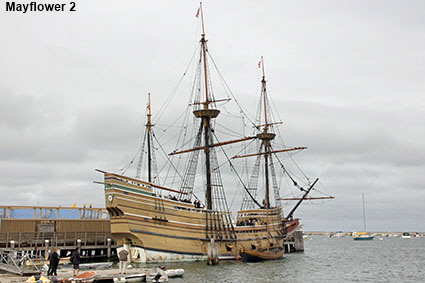
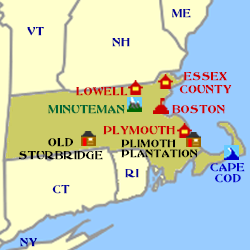

© Mike Elsden 1981 - 2025
The contents of this page may not be reproduced in full or in part without permission